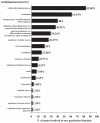Cycloheximide treatment to identify components of the transitional transcriptome in PACAP-induced PC12 cell differentiation
- PMID: 16787409
- PMCID: PMC4183198
- DOI: 10.1111/j.1471-4159.2006.03962.x
Cycloheximide treatment to identify components of the transitional transcriptome in PACAP-induced PC12 cell differentiation
Abstract
Pituitary adenylate cyclase-activating polypeptide (PACAP) promotes neurite outgrowth, reduces proliferation and inhibits apoptosis of PC12 cells. We have partially characterized the transcriptome changes induced by PACAP after 6 h of treatment, when commitment to differentiation has occurred. Here, we have investigated the effects of a 6-h treatment with PACAP (10(-7) m) in the presence of cycloheximide (5 microm) to identify, via superinduction, components of the transitional transcriptome initially induced by PACAP and potentially participating in the regulation of late-response genes required for differentiation. Approximately 100 new transcripts were identified in this screen, i.e. as many individual genes as make up the 6-h PACAP differentiation transcriptome itself. Six known transcripts in this cohort were then measured at several time points between 0 and 6 h by real-time PCR to determine whether these transcripts are induced early following PACAP treatment in the absence of cycloheximide, and therefore may be of functional importance in differentiation. Five out of the six transcripts were indeed induced by PACAP alone soon (between 30 min and 3 h) after cell treatment. beta-Cell translocation gene 2, antiproliferative (Btg2), serum/glucocorticoid-regulated kinase (Sgk), nuclear factor for the kappa chain of B-cells (NFkappaB), seven in absentia homologue 2 (Siah2) and FBJ osteosarcoma related oncogene (Fos) showed a 2.5-200-fold induction by PACAP between 15 min and 3 h, and mRNA levels returned either to baseline or near baseline after 6 h. This work provides new information concerning genes whose transient regulation early after PACAP exposure may contribute to the expression of the differentiated transcriptome in PC12 cells, and should help to elucidate the molecular mechanisms involved in the control of nerve cell survival and differentiation.
Figures




References
-
- Basille M, Vaudry D, Coulouarn Y, Jégou S, Lihrmann I, Fournier A, Vaudry H, Gonzalez BJ. Comparative distribution of pituitary adenylate cyclase-activating polypeptide (PACAP) binding sites and PACAP receptor mRNAS in the rat brain during development. J. Comp. Neurol. 2000;425:495–509. - PubMed
-
- Benn SC, Perrelet D, Kato AC, Scholz J, Decosterd I, Mannion RJ, Bakowska JC, Woolf CJ. Hsp27 upregulation and phosphorylation is required for injured sensory and motor neuron survival. Neuron. 2002;36:45–56. - PubMed
-
- Corrente G, Guardavaccaro D, Tirone F. PC3 potentiates NGF-induced differentiation and protects neurons from apoptosis. Neuroreport. 2002;13:417–422. - PubMed
Publication types
MeSH terms
Substances
Grants and funding
LinkOut - more resources
Full Text Sources

